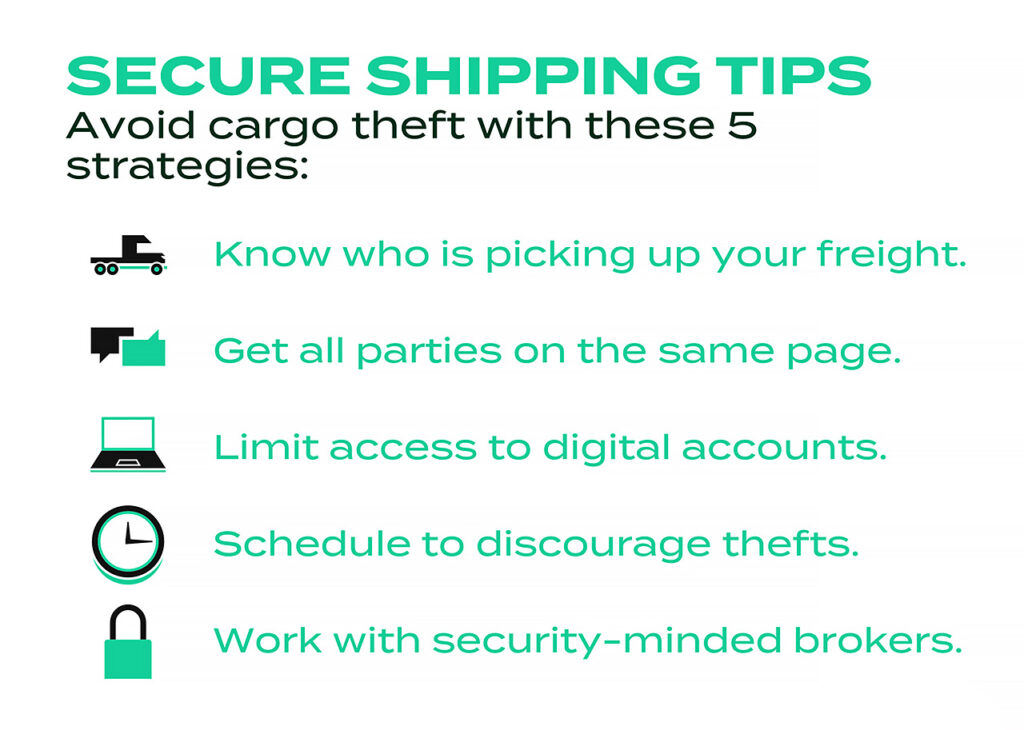It’s vitally important to every shipper, but no one wants to think about it — that’s right, we’re talking about freight security.
Incidents of cargo theft have been steadily on the rise. Logistics industry security watchdog CargoNet reports that thefts rose 15% from 2021 to 2022 resulting in an estimated $223 million worth of cargo stolen last year in the U.S. and Canada.
And in the second quarter of 2023 alone, 582 thefts of freight in the U.S. were reported to CargoNet, a 57% Y/Y increase.
46% of these incidents take place in just three states — California, Texas and Florida — but cargo theft can occur anywhere.
It’s not just carriers’ responsibility to prevent cargo theft. Freight security is a collective effort that should include all participants up and down the supply chain communicating openly and acting in step with one another.
Read our five shipper best practices for preventing freight theft and learn to take a more active role in the security of your cargo.
What Types of Cargo Theft Should You Look Out For?
Thefts of freight tend to fall into one of two categories. These are:
Direct Theft
This is typically a crime of opportunity in which thieves identify an unsecured load and physically steal it from the driver.
But while this relies on a momentary lapse in attentiveness on the part of the driver, it is also the product of careful observation and planning on the part of the thieves.
Bad actors who want to perpetrate this kind of cargo theft often observe facilities where they know high-value goods will be departing and follow drivers to their first stop. If the driver takes a lengthier break at a truck stop within close proximity to the pick-up facility, the opportunity will present itself for the trailer to be broken into or stolen.
Indirect Theft
This is a combination of cyber fraud, identity theft, and physical theft of goods.
In some cases, a bad actor may get access to load board login credentials for a reputable carrier and hijack freight by bidding to pick it up as that carrier.
In others, a well-meaning carrier may be fraudulently hired to deliver freight to an incorrect destination where it will be retrieved by the thieves.
In both instances, the physical theft of goods has the appearance of a legitimate transaction, a layer of deception that can be difficult for shippers to see through.
5 Shipper Best Practices for Avoiding Cargo Theft

1. Know Who Is Picking Up Your Freight
Sometimes the most effective action is the simplest one — when a driver arrives to pick up your shipment, ask them for identifying information that you can verify with your broker.
This should occur promptly, as soon as the driver shows up at your facility.
But don’t just ask them to tell you, ask them to show you. Take photographic evidence of their CDL, the DOT number on their truck and the name of their trucking company. You can run this by your shipper rep at your provider to confirm that it matches their record of who was dispatched to pick up your freight.
Making carrier verification part of your SOP for freight pick-ups leads directly into our next tip…
2. Get Everyone on the Same Page
Every person involved in the movement of your freight should have the same commitment to security that you do.
It might be pretty straightforward to align your internal team on your standards, but if you’re one of the 75% of shippers who outsource at least some of your supply chain, you will need to have important conversations with some third parties.
This can be especially important if you are transporting freight out of a third-party facility. Make sure everyone who will be involved in loading the freight on-site has been briefed about your expectations for communication and verification.
3. Limit Access to Digital Accounts
If you use digital tools to manage your supply chain, you’ll likely be able to add multiple users to your company account with their own login credentials. Take advantage of this capability — don’t let multiple people sign in as a single user.
It’s a key tenet of cybersecurity that the more widely a password is shared, the more it is at risk of being compromised. Stress to your team how important it is to maintain password integrity.
Adding multiple credentialed users to your company account can help you make sure the right people on your team have access to the right information — many digital freight tools let you assign different user types to people to control their permissions.
Finally, a great way to know your freight provider is looking out for your security is if they require multi-factor authentication (MFA) to view sensitive information in their digital platforms. We require carriers in our network to verify their identity with MFA in order to access our digital load board.
4. Schedule Shipments to Minimize Opportunities for Theft
Direct opportunity theft of freight takes place when the freight is unattended. With that in mind, it makes sense to avoid lengthy periods when it’s not on the road if possible.
This often means scheduling shipments so that they don’t run across weekends, or don’t otherwise run up to the end of the driver’s available service hours. If you schedule over the weekend, you might be looking at 1-2 days of the trailer sitting unattended.
You should also communicate with your carrier about best practices regarding stops. Most opportunity thefts occur a short distance from the pick-up facility, so ask that the driver travel 200 miles or more prior to a stop to minimize this vulnerability.
5. Work With Brokers Who Are Committed to Security
You need to trust the brokers you work with, both to connect you to reputable carriers who are going to take security seriously and to respond quickly and effectively if an incident does occur.
Ask your reps how they vet carriers and what internal processes they have in place to make sure they are trustworthy. They should be confident in their protocols and happy to discuss them.
A good sign to look for when choosing a provider is whether they work with any of the major theft monitoring organizations out there. CargoNet, the Transported Asset Protection Association (TAPA) and Overhaul are great organizations for your brokers to work with.
It’s even better if they’ve won a security award from one of them.
Your provider should also use one of the industry-standard vendors like Truckstop’s Registry Monitoring Insurance Services (RMIS) to onboard new carriers into their brokerage. These companies help perform background checks and verify carrier identification.
If a cargo theft does unfortunately occur, larger brokers with extensive assets really excel. They may have contacts with law enforcement agencies who investigate thefts, and if the missing freight cannot be located, they have the financial backing to make you whole.


